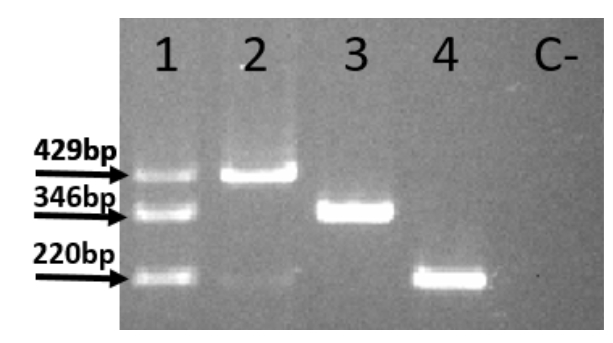Evaluation of a multiplex PCR for simultaneous detection of Bos taurus, Bubalus bubalis and Salmonella spp. in ground beef marketed in Marajó island
DOI:
https://doi.org/10.56825/bufbu.2022.4143083Keywords:
Bubalus bubalis, buffaloes, species identification, adulteration, fraud, bovineAbstract
The present work intends to use a mPCR for simultaneous detection of Bos taurus, Bubalus bubalis and Salmonella spp. in samples commercially available on Marajó Island, Pará State, Brazil. For this purpose, a mPCR reaction with different concentrations of DNA and primers with different annealing temperatures was optimized. Next, 28 samples of ground meat marketed as being of bovine origin were collected and a mPCR for the determination of species and for the detection of Salmonella spp. were realized. The results demonstrated the efficiency of the proposed technique for identification of Bos taurus, Bubalus bubalis and Salmonella spp. We conclude that the proposed mPCR technique is efficient and that buffalo meat is marketed as bovine on the Island of Marajó and that such frauds violating the current legislation that normalizes the commercialization of ground beef.
Downloads
Metrics
References
Agência Nacional De Vigilância Sanitária. 2001. Aprova Padrões Microbiológicos Para Alimentos. Agência Nacional De Vigilância Sanitária (ANVISA), São Paulo, Brasil.
Ali, M.E., M.A. Razzak, S.B.A. Hamid, M.M. Rahman, M.A. Amin, N.R.A. Rashid and A. Rakhine. 2015. Multiplex PCR assay for the detection of five meat species forbidden in Islamic foods. Food Chem., 177: 214-224. DOI: 10.1016/j.foodchem.2014.12.098
Barbetta, P.A., A.C. Bornia and M.M. Reis. 2004. Estatística Para Cursos de Engenharia e Informática, 3rd ed. São Paulo, Brazil. 376p.
Beer, A. 1852. Bestimmung der Absorption des rothen Lichts in farbigen Flüssigkeiten. Ann. Phys-Leipzig, 162(5): 78-88. DOI: 10.1002/andp.18521620505
Blaskovsky, C., I.M. Silva, R.L. Caldas and J.C. Maia. 2010. Avaliação primária da infra-estrutura para implementação de indústria de beneficiamento de “queijo do Marajó” no município de Cachoeira do Arari-PA. Inovação, Gestão e Produção, 2(1): 52-59.
Cabrera, M.C. and A. Saadoun. 2014. An overview of the nutritional value of beef and lamb meat from south America. Meat Sci., 98(3): 435-444. DOI: 10.1016/j.meatsci.2014.06.033
Cheung, P.Y. and K.M. Kam. 2012. Salmonella in food surveillance: PCR, immunoassays, and other rapid detection and quantification methods. Food Res. Int., 45(2): 802-808. DOI: 10.1016/j.foodres.2011.12.001
IBGE. 2012. Censo Agropecuário. Instituto Brasileiro De Geografia E Estatística, São Paulo, Brazil.
Karabasanavar, N.S., S. Singh, D. Kumar and S.N. Shebannavar. 2013. Development and application of highly specific PCR for detection of chicken (Gallus gallus) meat adulteration. Eur. Food Res. Technol., 236(1): 129134. DOI: 10.1007/s00217-012-1868-7
Lambert, J.H. 1760. Photometria, Sive de Mensure et Gradibus Luminis, Colorum et Umbrae, 2nd ed. W. Engelmann, Leipzig, German.
López-Calleja, I., I. González, V.A. Fajardo, M.A. Rodríguez, P.E. Hernández, T. García and R. Martin. 2005. PCR detection of cows’ milk in water buffalo milk and mozzarella cheese. Int. Dairy J., 15(11): 1122-1129. DOI: 10.1016/j.idairyj.2004.12.003
Ministério da Agricultura, Pecuária e do Abastecimento. 2003. Ministério da agricultura, Pecuária e do abastecimento, instrução normativa nº 83, de 21 de Novembro de 2003. Regulamento Técnico de Identidade e Qualidade de Carne Moída de Bovino, Diário Oficial da União, São Paulo, Brazil.
Motta, M.R.A., M.A. Belmonte and J.C. Panetta. 2000. Avaliação microbiológica de amostras de carne moída comercializada em supermercados da região oeste de São Paulo. Revista Higiene Alimentar, 14(78/79): 59-62.









.png)








